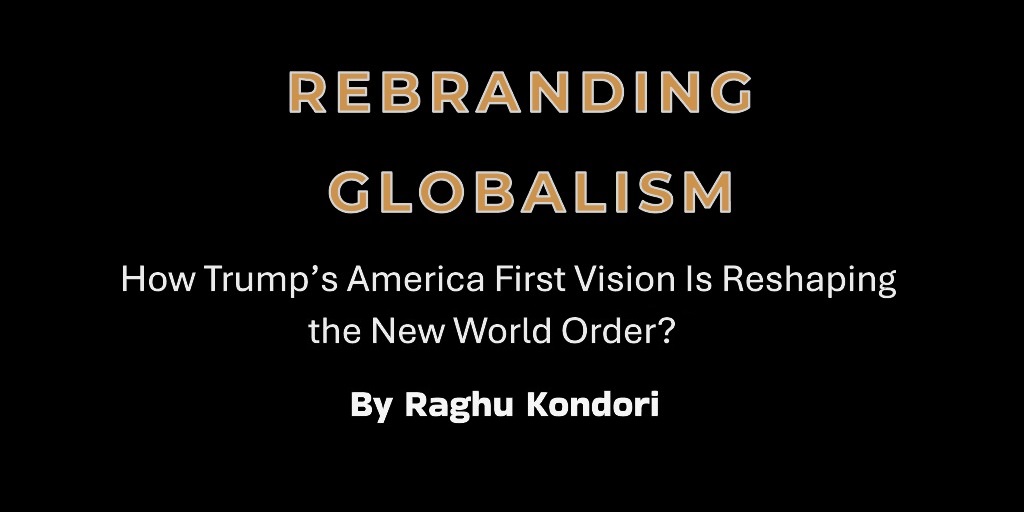Rebranding Globalism

Right Globalism, Left Globalism
How Trump’s America First Vision Is Reshaping the New World Order?
By Raghu Kondori
Globalism, traditionally driven by the global left through economic and political integration, is not disappearing—it’s evolving. This shift isn’t about globalism’s demise but a reconfiguration of its priorities, driven by new economic, political, and strategic imperatives. Historically, the global left has shaped globalism, but if Donald Trump’s right-wing agenda prevails, globalism may pivot toward a conservative trajectory. America, under Trump’s leadership, is rebranding globalism to ensure U.S. hegemony, using strategic moves to reshape the New World Order.
Greenland as a Strategic Move
A key step in America’s rebranded globalism is the proposed acquisition of Greenland (Web ID: 0, The Arctic Institute). This move would secure critical resources like rare earth minerals and oil, while providing geopolitical leverage in the Arctic. It positions the U.S. to dominate the North, countering Russian and Chinese ambitions, and establishes a strategic maritime neighbor to the EU via Denmark. This expansion of American influence is a tangible example of rebranded globalism, prioritizing U.S. interests within a global framework.
Separating Russia from China
Trump’s strategy also includes aligning with Russia to counter China (Web ID: 1, Council on Foreign Relations). China and Russia have deepened their strategic and economic ties, aiming to reduce the dollar’s dominance and promote alternative global institutions. By driving a wedge between them, Trump weakens China’s global position, freeing U.S. resources to support anti-China partners in Asia and leveraging Russia’s ties in South and Southeast Asia to isolate China further. This move reasserts American dominance in a multipolar world, redefining globalism under a conservative lens.
Iran’s Regime Change as a Linchpin
Securing Israel and stabilizing the Middle East requires addressing Iran’s current regime, a regional adversary since the 1979 Islamic Revolution (Web ID: 2, Kyodo News). A regime change to a constitutional monarchy under the Pahlavi dynasty, as existed in the 1970s, would transform Iran into an ally for peace. During the Pahlavi era, Iran maintained diplomatic ties with Israel and supported U.S. interests, balancing Middle Eastern power dynamics. Restoring this monarchy would secure Israel, counter threats like ISIS, and shift the regional balance, incentivizing Russia to align with the U.S. against China (Web ID: 1). This would solidify America’s leadership in a rebranded globalism, with a stable Middle East as a foundation for the New World Order.
Building the Right Alliance
America’s rebranded globalism requires a coalition of right-leaning allies: Argentina, with its free-market stance under Javier Milei; Italy, led by Giorgia Meloni’s nationalist government; Hungary, under Viktor Orbán’s conservative leadership; India, balancing nationalism and growth under Narendra Modi; and Israel, a key U.S. partner. This alliance amplifies U.S. influence, ensuring a global framework that prioritizes conservative values over the global left’s traditional approach.
America First as Global Hegemony
Trump’s rebranded globalism evolves the America First doctrine. The Greenland acquisition expands U.S. territory, the Russia-China separation weakens competitors, and the alliance with Argentina, Italy, Hungary, India, and a reformed Iran strengthens America’s global position. This approach prioritizes U.S. economic, strategic, and ideological interests, maintaining a global framework led by conservative values.
Challenges and Implications
This vision faces challenges: America First purists may resist any globalism, and left-leaning nations could push back. However, if Trump frames this as a win for American interests—securing resources, weakening adversaries, and ensuring regional stability—these hurdles can be overcome. Support from figures like Elon Musk, whose innovations through xAI can drive technological advancements, and Trump’s policy influence can ensure America’s dominance in this rebranded global order.
New World Order
A new world order is taking shape. America, under Trump’s leadership, is rebranding globalism to ensure U.S. hegemony, leading with allies like Argentina, Italy, Hungary, India, and Israel, and securing the Middle East through Iran’s regime change. By balancing economic, strategic, and ideological priorities, this conservative redefinition of globalism positions America to lead a fairer, more stable global order.


